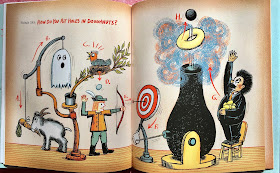 Visit Alyson Beecher on Wednesdays for Non-Fiction Picture Books at Kidlit Frenzy. Thanks to her hosting and sharing and those who add their posts discover and celebrate terrific nonfiction picture books! I always learn from these books, am happy that they are more and more available today for children, for everyone!
Visit Alyson Beecher on Wednesdays for Non-Fiction Picture Books at Kidlit Frenzy. Thanks to her hosting and sharing and those who add their posts discover and celebrate terrific nonfiction picture books! I always learn from these books, am happy that they are more and more available today for children, for everyone!
Edward Binney and his staff get the prize for giving children crayons, safer than the older, not useful or safe, artist's crayons. In those early days, paper was too expensive so children wrote with a gray pencil, on slate tablets. They worked but rubbed off too easily. Natascha Biebow tells the story starting with the 'need' for crayons of the colors of the world so children could draw them. Binney's wife knew about this. She was a teacher. And Biebow takes the reader through pages of persistence, experimentation, and finally, the celebrated result, CRAYOLA CRAYONS! Within the book, boldface type shows up in the names of the colors throughout the story. Steven Salerno's illustrations themselves are filled with action, from a "lightbulb' above Binney's head to him and his staff working hard to find just the right mix of wax, clay, and pigment - whew! Each night they headed home covered with color! They wanted to get this invention just right, and they finally did.
Biebow includes a bibliography with both primary and secondary sources, interviews with Binney’s great-granddaughter, plus additions in text boxes throughout the book that offer additional informational snippets such as the composition of Crayola’s pigments. There is a wonderful author's note telling how much Edward Binney and his partner, Harold Smith gave back to the community and a page that shares real factory pictures of how crayons are made today.
 |
| Delightful endpapers! |
 |
| Introduction at the World's Fair
What fun it will be to share this with children who may not know the background of their favorite art crayon.
In her beginning pages, Sarah Aronson describes artist and inventor Rube Goldberg like this: “In a funny way, his life was just like one of his famous inventions: an improbable and inefficient chain reaction that ends up making perfect sense. Goldberg immersed himself in drawing in his younger years, but his parents didn’t support his plans to become a cartoonist, so he chose engineering. After a very brief time, he quit his job to follow his dream, to draw. And he did. After doing cleaning work at the San Francisco Chronicle, Goldberg kept on drawing. He did get his breakthrough; they began publishing his cartoons and a column. Disaster came in the San Francisco fire of 1906. He drew comics to cheer people up. And Goldberg also realized he had to make a change, so traveled to New York City, became a columnist at a big paper. At last, Goldberg's talent is revealed. In the marvelous machines we all know and drawn with hilarious "Goldbergian" detail by Robert Neubecker, Aronson reveals Professor Lucifer Gorgonzola Butts, “who invented one intricate machine after another.” His art depicts several of Professor Butts’s contraptions—one that elaborately punches holes in doughnuts, another that turns off a light. If you or the children with whom you share this book aren't familiar with Rube Goldberg machines, they will adore them, first want to draw, then create their own.
This project was a favorite of my students when I taught. Together we created a set of goals, (like bounce a ball, hammer a nail, mix up instant pudding, etc.) and in teams of two or three, they had a number of weeks to "make" the machine. How wonderful it would have been to have had this book then! The lobby of our Children's Hospital has an elaborate one for everyone to enjoy. And you can find examples of drawings and machines on YouTube.
|




As a reluctant nonfiction reader, I must admit that I've added both of these books to my request list at the library. Didn't you just love the Mr. Roger's episode filmed at the crayola factory? Thanks to your Wednesday posts, I keep dipping into wonderful nonfiction. Thanks, Linda!
ReplyDeleteBoth are delightful, Ramona. I have not seen the Mr. Rogers episode, will see if I can find it! Thanks!
DeleteI am anxiously awaiting The Crayon Man's arrival at my library! The Rube Goldberg biography is new to me. Thanks for the suggestion. I am going to see if my library has it yet.
ReplyDeleteHope you can find both soon! They are terrific! Thanks!
DeleteThat looks like such a great book!
ReplyDeleteAnd by the way, I love your new header! The daffodils aren't blooming yet where my daughter lives, so nobody's sending me daffodil photos yet!
ReplyDeleteI took that picture last year, but just saw some daffodils yesterday, finally! Thanks, Ruth!
Delete